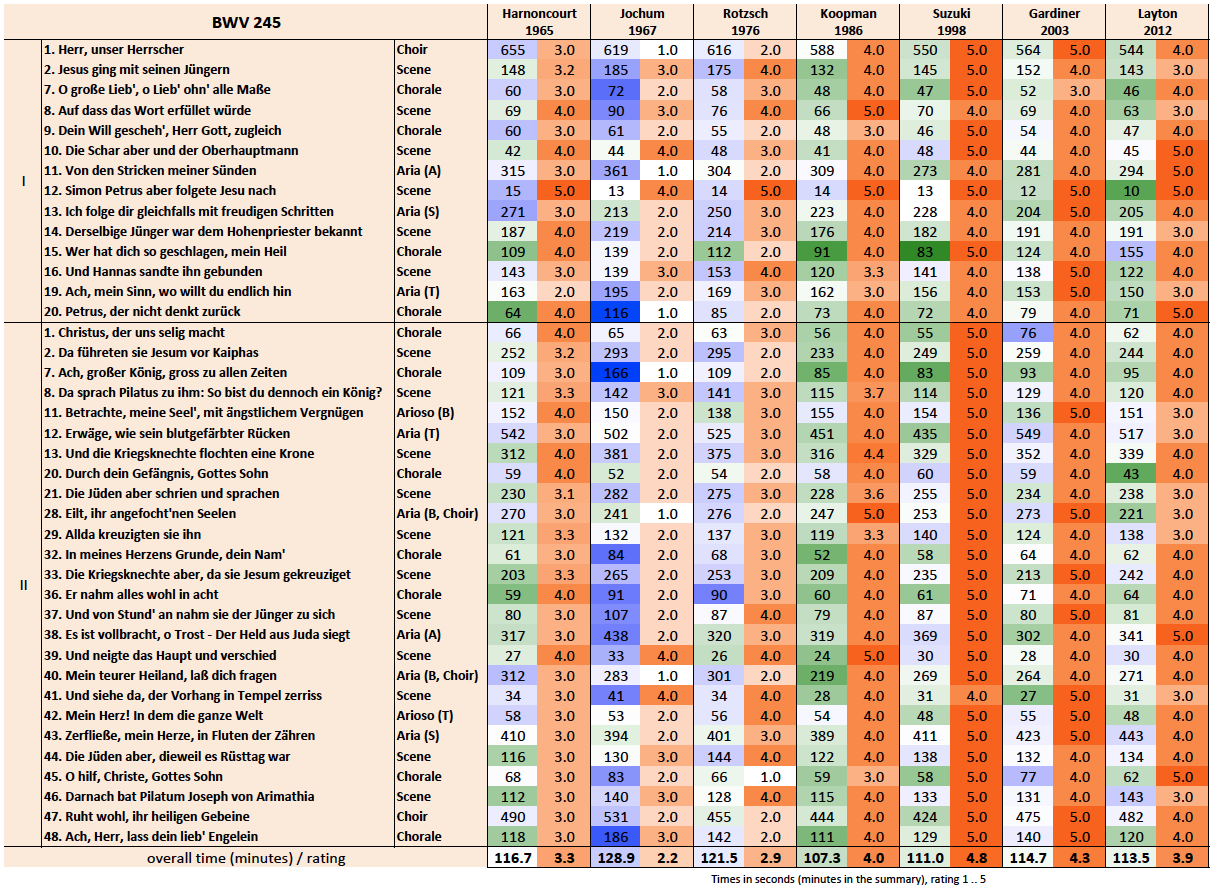Johann Sebastian Bach
St.John Passion, BWV 245
Media Review / Comparison
2013-06-24 — Original posting (on Blogger)
2013-12-20 — Typos corrected, link added
2014-11-09 — Re-posting as is (WordPress)
2016-07-12 — Brushed up for better readability
Table of Contents
- Intro — Johann Sebastian Bach (1685 – 1750): St.John Passion, BWV 245
- Discography
- Comparison
- Comments on the Interpretations
- Eugen Jochum , Royal Concertgebouw Orchestra, Netherlands Radio Chorus
- Hans-Joachim Rotzsch , Gewandhaus-Orchester Leipzig, Thomanerchor Leipzig
- Nikolaus Harnoncourt (1929 – 2016), Concentus musicus Wien, Wiener Sängerknaben
- Stephen Layton , Orchestra of the Age of Enlightenment, Polyphony
- Ton Koopman , The Amsterdam Baroque Orchestra, Koor van de Nederlandse Bachvereniging
- John Eliot Gardiner , English Baroque Soloists, Monteverdi Choir
- Masaaki Suzuki , Bach Collegium Japan
- Review Summary, Recommendation
Intro — Johann Sebastian Bach (1685 – 1750): St.John Passion, BWV 245
Several ideas led to this review:
- catching up (on CD) with recordings that I have in my LP collection: Harnoncourt, Jochum, Rotzsch
- compare these with recordings that I later added on CD: Koopman
- adding select newer recordings: Suzuki (not present in my collection at all, so far), Gardiner (considering his new recording of the Bach motets), Layton (because I like the choir, Polyphony, and more so because of Ian Bostridge singing the evangelist).
Discography
The Jochum recording was my first acquisition on LP, some 40 years ago, Rotzsch was added because of Peter Schreier. Harnoncourt reflected my growing interest in historically informed recordings. Koopman was added on CD because for a while I intended not to duplicate recordings that I had on LP (I have since reversed that decision). In Bach’s passions, the role of the evangelist is as important as that of the conductor. In several instances, that tenor role was the key driver in my purchases. Here are the recordings that I compared, in chronological order (recording year):
- 1965: Harnoncourt / Equiluz
- 1967: Jochum / Haefliger
- 1976: Rotzsch / Schreier
- 1993: Koopman / de Mey
- 1998: Suzuki / Türk
- 2003: Gardiner / Padmore
- 2012: Layton / Bostridge
Here is the discographical information:
Harnoncourt / Equiluz
Johann Sebastian Bach: Johannes-Passion BWV 245
Nikolaus Harnoncourt, Concentus musicus Wien, Kurt Equiluz (Evangelist), Max van Egmond (Jesus), Bert van t’Hoff, Jacques Villisech, Siegfried Schneeweis, Wiener Sängerknaben (Hans Gillesberger)
Teldec / Warner 2564 69644-4 (2 CDs, stereo); ℗ 1971 / © 2008

Jochum / Haefliger
Johann Sebastian Bach: Johannes-Passion BWV 245 / Kantate BWV 140 “Wachet auf, ruft uns die Stimme”
Eugen Jochum, Royal Concertgebouw Orchestra, Ernst Haefliger (Evangelist), Walter Berry (Jesus), Agnes Giebel, Marga Höffgen, Alexander Young, Franz Crass, Netherlands Radio Chorus (BWV 245)
Raymond Leppard, English Chamber Orchestra, Elly Ameling, Aldo Baldin, Samuel Ramey, London Voices (BWV 140)
Philips 462 173-2 (2 CDs, stereo); ℗ / © 1998

Rotzsch / Schreier
Johann Sebastian Bach: Johannes-Passion BWV 245
Hans-Joachim Rotzsch, Gewandhaus-Orchester, Peter Schreier (Evangelist), Theo Adam (Jesus), Arleen Augér, Heidi Rieß, Armin Ude, Siegfried Lorenz, Thomanerchor Leipzig
RCA / BMG 74321 49181 2 (2 CDs, stereo); ℗ 1976 / © 1998

Koopman / de Mey
Johann Sebastian Bach: Johannes-Passion BWV 245
Ton Koopman, The Amsterdam Baroque Orchestra, Guy de Mey (Evangelist), Peter Kooij (Jesus), Barbara Schlick, Kai Wessel, Gerd Türk, Klaus Mertens, Koor van de Nederlandse Bachvereniging (Jos van Veldhoven)
Erato 4509-94675-2 (2 CDs, stereo); ℗ / © 1994

Suzuki / Türk
Johann Sebastian Bach: Johannes-Passion BWV 245
Masaaki Suzuki, Bach Collegium Japan, Gerd Türk (Evangelist), Chiyuki Urano (Jesus), Ingrid Schmithüsen, Yoshikazu Mera, Makoto Sakurada, Peter Kooij.
BIS-CD-921/922 (2 CDs, stereo); ℗ 1998 / © 1999

Gardiner / Padmore
Johann Sebastian Bach: Johannes-Passion BWV 245
John Eliot Gardiner, English Baroque Soloists, Mark Padmore (Evangelist), Hanno Müller-Brachmann (Jesus), Katharine Fuge, Joanne Lunn, Bernarda Fink, Peter Harvey, Monteverdi Choir
SDG 712 (2 CDs, stereo); ℗ / © 2011

Layton / Bostridge
Johann Sebastian Bach: Johannes-Passion BWV 245
Stephen Layton, Orchestra of the Age of Enlightenment, Ian Bostridge (Evangelist), Neal Davies (Jesus), Carolyn Sampson, Iestyn Davies, Nicholas Mulroy, Roderick Williams, Polyphony
hyperion CDA67901/2 (2 CDs, stereo); ℗ / © 2013

Comparison
Result Overview
The table above lists the durations for the various sections of the composition, as well as my rating for each section. The numbering follows the segmentation / track numbering in the recordings with Nikolaus Harnoncourt and Ton Koopman (both 20 + 48 tracks). This is essentially the “traditional” numbering scheme. The new Bärenreiter Edition (Arthur Mendel, 1979) separates the composition by “scenes” (collecting subsequent recitativi, turbae, etc. into one track), arias, and choral pieces, leading to typically 14 + 26 tracks.
The rating above follows this track scheme, the fractional ratings with Harnoncourt and Koopman are the result of averaging the results for the smaller tracks.
Pitch
A note about the pitch: the recordings by Eugen Jochum (Royal Concertgebouw Orchestra, Amsterdam) and Hans-Joachim Rotzsch (Gewandhaus-Orchester Leipzig) play with a pitch of a’=440 (Rotzsch is even slightly above that). All other recordings use the (more appropriate) baroque pitch of a’=415 Hz (half a tone below the modern standard pitch).
Focal Points in the Comparison
I’ll not compare these recordings track by track, but instead I try summarizing my comparison findings by pointing out key features in the various interpretations. In the section below, the order follows my rating. Some general remarks on my expectations:
- In my mind there is no doubt that the times of the performances with big, modern orchestras and huge choirs is over for this composition.
- This is Bach’s substitute for opera compositions (which were not in the scope of his several employments), so the focus should be on telling a story — the story of the passion of Christ, as told by the bible. This precludes an excess of abstraction, but it also precludes an excess of drama and self-exhibitionism.
- The central figure is the Evangelist — he is omnipresent and tells the story, as taken literally from the bible, in (a descendant of) Martin Luther’s translation.
- The role of Jesus is a difficult one. Out of respect for the subject, most recordings have one singer dedicated to this role, which makes this a rather small role. Yet, this should be a well-sounding, round, calm, maybe authoritative, but in my mind also unpretentious voice.
The Choir
The choir must fulfill several roles:
- The big entry (I.1) and closing (II.47) choirs call for a big, but not massive choir: yes, it should show the greatness of the subject — but yet should be adapted to the power of a moderate size orchestra with period instruments.
- In their nature, the chorales stem from community singing, so should not be too artful, natural in phrasing and tempo. They show popular reflections on the action in the drama that is unfolding.
- In the turbae, on the other hand, the choir must fulfill a variety of roles, from the rage of an excited or furious crowd to discussions among the high priests, down to debates within a few soldiers. In my mind, particularly this latter role precludes the use of a boys’ or children’s choir, and it is probably best not to use the full choir throughout.
Two pieces are extremely demanding for the choir: for one, the intonation of the “Wohin?” interjections in II.28 (aria “Eilt, ihr angefocht’nen Seelen”) is very demanding even for professional choirs (see Jochum below). Also, the virtuosic coloraturas in the turba choir “Lasset ins den nicht zerteilen” are probably beyond the abilities of most non-professional choirs.
Overall, I think that (especially for the choir) mere perfection is not the key to success here. I personally regard expression and a natural, understandable language, as well as clear diction at least as important.
Other Aspects
- With the exception of Pontius Pilatus and Petrus (ideally requires two additional basses), the other scenic roles are less demanding & less critical to the outcome of the performance.
- Then, there is a series of arias and ariosos for four solo voices: two for soprano (I.13; II.43), two for alto (I.11; II.38), three for tenor (I.19; II.12; II.42), and four for bass (II.11; II.24; II.28; II.40). These may not be technically extremely demanding — but they are demanding nevertheless, given that they are poetic reflections on a dramatic, tragic story (in a pietistic context)!
- Finally, on the language: as mentioned above, the purpose of this composition is to tell a story to people in a church, so the language is core to the interpretation. This can’t be translated, as Bach wrote this for and in the German language (even though the Saxonian dialect may have made this sound somewhat different from what some might think!). German language natives (including myself, even though I’m Swiss) are likely more critical towards distortions in the pronunciation than, say, anglo-saxon listeners.
Comments on the Interpretations
Eugen Jochum, Royal Concertgebouw Orchestra, Netherlands Radio Chorus
This was recorded in 1967: this was my first recording on LP. It’s probably not all that far from the performance(s) with the Zurich Bach Choir (under Peter Eidenbenz, with the Tonhalle Orchestra Zurich, if I remember correctly) that I experienced from within the choir: definitely a traditional, “non-HIP” performance. It features a sound that is often a bit dull, undifferentiated: overall, Jochum prefers slow, at most moderate tempi. The orchestra is big, using modern instruments. Of course, the orchestra performs flawlessly, though it lacks the vivid colors of period instruments. Modern woodwinds have more volume than period instruments, which justifies a bigger string body.
In general, the articulation reflects the Zeitgeist, often using strict legato (e.g.: the flute in the soprano aria I.13), rather than the lighter articulation that is in use with historically informed interpretations. Another example: the accompaniment to the tenor aria I.19).
Choir
The choir is professional, also huge. They sing like a typical 19th/20th century opera choir: massive, with lots of vibrato. This makes me feel like they are about to sing “Va, pensiero…”. Not much joy in this context. The opening choir is complemented by a big organ, making it even more massive. The “Wohin?” interjections in II.28 are oddly imprecise in the intonation. II.34 (“Lasset uns den nicht zerteilen”) is OK technically, though clumsy and heavy / schematic.
Chorales
With the chorales Jochum mostly takes extremely slow / broad tempi. That makes listening to these pieces almost painful. The result does not carry much of the message / contemplation / reflection in these pieces. There is more to chorales than making them “great” / “huge” bombastic…
Evangelist, Jesus
- Ernst Haefliger (evangelist) is unpretentious, natural, “just telling the story”. His voice doesn’t have the brilliance, the “ping” of some of the contenders in this comparison, but I really like him in this role. He masters the challenge of the high pitch amazingly well; to me, this is clearly the best part of this recording!
- Walter Berry (Jesus): a warm, harmonious voice, solemn, reflective, intense — sometimes at the fringe of celebrating.
Other Soloists
- Agnes Giebel (soprano): too much vibrato, often somewhat coarse in the articulation; in the second aria (II.43) I sense some unrest in her voice.
- Marga Höffgen (alto) sure was a great voice — but her vibrato was horrible, at least from today’s perspective (maybe usable for one of the Vakyries!). In the vivace part of her second aria (II.38), one is tempted to shout “fasten seat belts!”, as her vibrato conflicts with her semiquavers. In the slow parts of that aria, the viola da gamba exhibits a vibrato almost as strong as the singer’s. I double-checked the booklet with the LP set (much richer than the meager one that comes with the CD!), and that sure claims it’s a viola da gamba. Such string vibrato is hardly doable on a fretted instrument, let alone adequate for this type of instrument (and the period in which they were originally used) in general — did they use a viol without frets???
- Alexander Young (tenor): good voice, but far too theatrical, like arias from a romantic opera, with too much vibrato and legato throughout, and with occasional “glissando” at the start of certain notes.
- Franz Crass (bass): a very nice, well-balanced (slightly “covered”) voice — though the interpretation is rather romantic, as the rest of this recording.
Hans-Joachim Rotzsch, Gewandhaus-Orchester Leipzig, Thomanerchor Leipzig
This was recorded in 1976. Rotzsch avoids Jochum’s extremely slow tempi, but overall, his interpretation remains heavy and on the slow side. Another big, traditional (romantic) orchestra, as with Jochum: it may be performing flawlessly, but is nevertheless no longer appropriate for this composition. Also largely using legato articulation, see above.
Choir
The choir is probably the weakest part of this interpretation, with the Thomanerchor not sounding like a boys’ choir, but more like a children’s choir. They may be singing correctly, but they really sound like children: too young and innocent for the seriousness and depth of the subject, or — to pick a specific example — simply inappropriate to impersonate a group of high priests. The “Wohin?” interjections in II.28 are not precise in the intonation. II.34 (“Lasset uns den nicht zerteilen”) is the slowest in this comparison — clearly a tribute to the limitations of this choir.
Chorales
The chorales are more natural, more fluent than Jochum’s — unfortunately with the very bright timbre of a children’s choir, see above. I can’t see how a children’s choir can do justice to the deep, reflective nature of some of these chorales. Yes, the chorales come from community singing — this may not exclude young voices from contributing, but it can hardly mean children alone.
Evangelist, Jesus
- Peter Schreier (Evangelist) is just brilliant! His voice may not have the ultimate “ping”, the “silver / platinum radiance”, the “heart” of a Fritz Wunderlich; still, it is extremely dense, clear, engaging, intense, fast. Luckily, it avoids Ian Bostridge’s excess in drama and emphasis. In a way, Schreier is unique as evangelist, and as such certainly a highlight of this entire set of recordings — and probably the one and only highlight in this recording!
- Theo Adam (Jesus): while the evangelist is the highlight of this recording, Theo Adam unfortunately sets an awful counterpoint, with his over-heavy vibrato / wobbling. This strongly reminds me of his Wotan in Wagner’s “Der Ring des Nibelungen” that he recorded a few years later (again with an excellent Peter Schreier!).
Other Soloists
- Arleen Augér (soprano): her first aria (I.13) is very slow, with heavy vibrato — doesn’t quite match the “freudige Schritte” (joyful steps). The second aria (II.43) is too artful to me, even though she certainly has an impressive voice (Helmuth Rilling frequently engaged her for his Bach cantata series).
- Heidi Rieß (alto): the volume and the timbre of her voice are good, close to impressive, maybe lacking some control. I wish she was more careful in the articulation. The vibrato is rather strong for my taste, the intonation not always quite clean.
- Armin Ude (tenor): very good voice, well balanced, nice timbre (reminds of Peter Schreier). He is maybe a bit too dramatic / romantic, reinforced by the romantic orchestra with its strong instrumental vibrato throughout.
- Siegfried Lorenz (baritone, Pilatus): too much heavy vibrato, with a tendency to use bulge notes (II.11); fairly weak & inaccurate in II.28
Nikolaus Harnoncourt (1929 – 2016), Concentus musicus Wien, Wiener Sängerknaben
This was recorded in 1965. Amazingly, this is the oldest of the recordings in this comparison. Clearly it is also an early one for Harnoncourt, made at a time when he was yet to discover the right balance between historically informed / “correct” playing and the freedom of expression. With few exceptions, his tempi are more vivid than the two interpretations above. Still the interporetation is occasionally a bit heavy (sometimes maybe slightly over-pronounced) in the articulation, but clean and relatively transparent (thanks to the smaller ensemble and the period instruments). Clearly limited also in the recording / sound technique.
Choir
The choir sounds much more mature than the Thomanerchor — even though it is a boys’ choir. It is often hard to tell the difference to a choir with adult singers, offering good declamation in general, clean intonation. Exceptions: some of the “Wohin?” interjections in II.28 are slightly imprecise in the intonation, and in II.34 (“Lasset uns den nicht zerteilen”) the choir reaches its limits.
Chorales
The chorales are much better than with Rotzsch & the Thomanerchor, though often a bit schematic, with substantial pauses between the verses.
Evangelist, Jesus
- Kurt Equiluz (Evangelist): unpretentious, engaged, vivid, narrative — maybe at the upper limit with the vibrato.
- Max van Egmond (Jesus, Arioso II.11, aria II.40): too much vibrato for my taste, too dramatic and pretentious, though quite a nice voice.
Other Soloists
- Soloists from the Wiener Sängerknaben (soprano & alto): the alto voice is fairly good for a boy (maybe sometimes lacking breath). Where the boy fails is in the vivace part of the second alto aria (II.38), where the slow tempo (due to limitations in the boy’s ability to sing coloraturas) makes that part sound rather clumsy: clearly, using boys for this part has its limitations. Also the soprano voice is impressive for a boy, but still lacks volume, especially in the lower parts. In I.13 the intonation isn’t always quite clean, but in II.43 (a different boy?) it is definitely better.
- Bert van t’Hoff (tenor): not top-of-the range — a rather modest voice & performance, not always clean in II.12.
- Jacques Villisech (bass, Pilatus, aria II.28): OK, though limited volume, and the intonation isn’t always 100% clean in II.28.
- Siegfried Schneeweis (bass, Petrus): OK, not great (if not modest), with a somewhat heavy vibrato — though pretty good in II.11 (excellent balance with the very nice instrumental accompaniment).
Stephen Layton, Orchestra of the Age of Enlightenment, Polyphony
This was recorded in 2012. This is the newest recording in this comparison. My first encounter with Layton & Polyphony was with Bruckner recordings, where these artists are excellent, possibly the best I have. These were one reason for high expectations (an absolutely professional choir, expressive, virtuosic, excellent at intonation, etc.) the other component causing high expectations was Ian Bostridge as evangelist.
I can’t criticize the performance by the orchestra / the instrumentalists, and the tempi are good, in general — maybe sometimes lacking flexibility, agogic play…
Choir
The choir — well, too professional for this! There is too much vibrato, too much “power singing”, the voices often don’t mix very well. Yes, it’s near-perfect and often very virtuosic in the turbae — but the latter are meant to represent real people (high priests, soldiers, a crowd, etc.), and hence expression is far more important than perfection. Some of the choirs are also a bit schematic, too declamatory, sometimes almost rigid.
The “Wohin?” interjections in II.28 are no problem for this choir, obviously — even at Layton’s steep tempo selection. In II.34 (“Lasset uns den nicht zerteilen”) the choir is technically perfect and extremely virtuosic. But besides the precision and virtuosity the piece misses emotion and excitement, is rather static.
Chorales
Sung perfectly, but lacking the ultimate feel for the underlying language, occasionally sounding artificial. Some of the phrasing sounds unnatural, with some odd “artificial” breaks. on the other hand, sometimes verses are attached without breaks, and then at least that sounds less odd that with Gardiner. Occasionally (e.g.: II.20) there is a tendency to do a crescendo on every note, which I consider a bad habit.
Evangelist, Jesus
- Ian Bostridge (Evangelist): I like Ian Bostridge in his interpretations of Schubert Lieder (e.g., Die Winterreise). Here, he is a big disappointment for me! Yes, the underlying story is a dramatic one — bit this role is to tell from the very bible, not a modern drama. I also think that so much drama sounds far too artificial for a baroque composition in the tradition of the passions of previous centuries: Bach’s compositions are both the culmination and the end point of a long tradition. Drama might be OK, but that much vibrato / emotion in every single note??? I’m also disappointed by occasional mistakes in the diction, e.g., in I.16, “Da verleugnete Petrussabermal …” in lieu of “Petrus ‘abermal”, and then there’s the occasional “ash” in lieu of the German syllable “ach” (“akh“).
- Neal Davies (Jesus): also this part is way too dramatic, uses too much vibrato: this is not a romantic opera! I miss the solemn, authoritative aspect of this role. I think that in the pietist tradition this role deserves a more humble interpretation.
Other Soloists
- Carolyn Sampson (soprano): a good voice, but the vibrato is at the upper limit (maybe trying to be close to Ian Bostridge & Neal Davies?). In the first aria (I.13) the tempo is fast, but still OK for the character of the piece — though one feels a bit rushed / pushed. This isn’t a matter of the tempo alone, but more one of agogics.
- Iestyn Davies (countertenor) for me was the revelation and the highlight of this recording: a very nice voice, excellent singing, overall. The only (minor) criticism is in the diction: why are Dutch and English-speaking singers so afraid of pronouncing “ach” with a guttural “kh”??
- Nicholas Mulroy (tenor): not a great voice, with very moderate diction: “Ach” in I.19 almost sounds like “ash”, rather than “akh”. Also too nervous as a voice (also in the phrasing in I.19).
- Roderick Williams (bass): too much vibrato throughout, too celebrated in II.11; maybe a bit pushed in II.28; somewhat imprecise in the “messa di voce” in II.40 (or is this just the excess vibrato?).
Ton Koopman, The Amsterdam Baroque Orchestra, Koor van de Nederlandse Bachvereniging
This was recorded in 1986. This recording features better tempi than the early recordings above (often on the fast side, though, see the table above), good phrasing and dynamic differentiation.
Choir
The choir sounds rather big and relatively massive, but exhibits fairly good declamation, articulation. The pronunciation unfortunately isn’t always “German enough” for my taste. The “Wohin?” interjections in II.28 are very good & precise in the intonation, and in II.34 (“Lasset uns den nicht zerteilen”) the choir operates at its limits (the intonation and the precision in the rapid figures start to suffer) — though the tempo is fairly steep.
Chorales
The Chorales could be more “speaking”, use a more natural, “living” language flow: some of the (language) phrasing is a bit overdone, too schematic.
Evangelist, Jesus
- Guy de Mey (Evangelist): vivid, though often rather nervous in the vibrato and the language flow — not my top choice in this role.
- Peter Kooij (Jesus), also with a rather nervous vibrato, and somewhat of a “covered” timbre, but otherwise the character of this voice is OK (with the occasional pronunciation flaw).
Other Soloists
- Barbara Schlick (soprano): good, natural voice & articulation. The second aria (II.43) is very nice, with lute accompaniment. Maybe the oboi da caccia are sometimes in danger of covering the soprano in lower, soft passages.
- Kai Wessel (countertenor) sings with very limited vibrato (if any). I quite like this voice, except for the vivace part of her second aria (II.38), which is somewhat dry, flat, the voice somewhat “covered”.
- Gerd Türk (tenor): good, but not quite as convincing as in his role as evangelist 12 years later, with Suzuki: a nervous vibrato, occasionally not quite clear in past passages. The nervous tempo in II.19 is Koopman’s, presumably.
- Klaus Mertens (bass): good (lacking a some volume?), well balanced, good intonation, not exaggerating vibrato and drama.
John Eliot Gardiner, English Baroque Soloists, Monteverdi Choir
This was recorded in 2003 (live). This is a dramatic interpretation — dramatic from the direction & the overall concept, with good tempo selection, mostly excellent phrasing, overall balance, etc. — excellent, overall! Gardiner’s tempi are never extreme, rarely “on the slow side” (only in the opening chorale in the second part, this is the slowest performance).
Choir
The choir is very good, indeed: flexible, expressive, virtuosic, and with excellent diction / pronunciation; it almost sounds like a big choir. The booklet mentions a strength of 7 + 4 + 4 + 4, so some of this “big sound” must be the acoustics. The composition is demanding on the choir, and there is just one single instance towards the end where from a tiny moment of lacking attention one can gather how much effort goes into such a performance (I remember from my own experience how much one feels drained towards the end of this composition!). The “Wohin?” interjections in II.28 are excellent in rhythm & intonation (especially considering the live recording!).
The “showpiece” II.34 (“Lasset uns den nicht zerteilen”) is turbulent, emotional, yet very clear, transparent, virtuosic, precise without aiming for “cold” perfection.
Chorales
In the “old school” chorale singing was done verse by verse, with a very long / disrupting fermata between the verses. More recently, conductors were aiming for a more “natural” language flow, taking into consideration that often a sentence extends over several verses and should not be broken that much into verses. On the other hand, chorales stem from community singing, and there, one cannot expect people to sing very long phrases.
The real art is to sing the verses separated for breathing, but still leaving some sensation of a “logical” link between the parts of a sentence. Gardiner is sometimes linking verses directly — in a way that I don’t really feel at ease with. It sounds forced, maybe somewhat arbitrary, because it is not done consequently, or because it does not feel right from the melodic / rhythmic aspect. It’s a subtle thing, maybe a matter of language “feeling” (though I’m told that Gardiner is very familiar with the German language)?
Evangelist, Jesus
- Mark Padmore (Evangelist): excellent voice, good narrative overall, though with a tendency to an excess of drama & wild vibrato, reminding me of Ian Bostridge’s interpretation (an Anglosaxon “feature”?), occasional oddities in the German pronunciation.
- Hanno Müller-Brachmann (Jesus): good voice, not exaggerating drama or otherwise overdoing the role.
Other Soloists
- Joanne Lunn (soprano, aria I.13): excellent, natural, with little vibrato and very light articulation — an excellent voice / match for this aria!
- Katharine Fuge (soprano, aria II.43): excellent balance with instruments in this aria. Also this is a natural voice, maybe sometimes with a slight tendency to an excess of slow vibrato.
- Bernarda Fink (alto): a very nice voice, both in terms of volume and timbre. Unfortunately, she sings with a rather strong vibrato, though with very good intonation (mostly using “volume vibrato” only).
- Mark Padmore (tenor, arias): see above (the only recording where the evangelist also is singing the arias); very good. Occasionally a bit too dramatic (this may also be attributed to Gardiner, though, or to “the heat of the battle” in the live performance)
- Peter Harvey (bass, Pilatus, arias): very nice & expressive in II.11; nice and expressive in II.28; maybe almost too dramatic in II.40 — I prefer this piece to be more reflective.
Masaaki Suzuki, Bach Collegium Japan
This was recorded in 1998.
After I had completed my collection of all cantatas with Ton Koopman, I heard several raving reviews about Suzuki’s recordings of Bach cantatas, but I never added any of these to my collection. Here now I sensed an opportunity to experience Suzuki’s Bach interpretation — and it was very well worth it! This is an exquisite, historically informed recording, with excellent choir, vocal and instrumental soloists, good tempi & interpretation overall, as well as very good sound technique. If I were to start over, I would focus on Suzuki rather than Koopman for Bach’s vocal works!
The Score Version Used
This recording uses the the late version (IV) of the score, from 1749, featuring some slight alterations (mostly just text alterations) from the version we are used to hear. In addition, the recording includes an appendix with 3 extra arias from version II of the passion, from 1725):
- An extremely virtuosic bass aria with chorale (the latter sung by the soprano voices of the choir) “Himmel, reiße, Welt, erbebe” (BWV 245a) — in an absolutely top-notch interpretation. This was used as Part I, Nr.15, in lieu of the chorale “Wer hat dich so geschlagen, mein Heil“.
- An equally virtuosic tenor aria “Zerschmettert mich, ihr Felsen und ihr Hügel“, BWV 245b — again in a stunning performance. This was used as part I, Nr.19, in lieu of aria “Ach, mein Sinn, wo willt du endlich hin“.
- Finally, a tenor aria, accompanied by two oboes and B.c., “Ach windet euch nicht so, geplagte Seelen“, BWV 245c, to be used in lieu of II.19, the bass-arioso “Betrachte, meine Seel’“.
I’m tempted to say that even just for these extra 14 – 15 minutes of otherwise unheard music it was worth buying this recording, both for the music and for the excellent performance. Still, if I were conductor, I would be in a conflict whether to select the version from 1725: I would not hesitate to use the first two pieces, provided I had the singers and the instrumentalists who can master this (they are equally demanding for the instruments!) — but the arioso “Betrachte, meine Seel'” (with the accompaniment of two viole d’amore, a very moving piece!) for me is one of the “core pieces” of this passion and could hardly be left out, as an essential piece would be missing!
Choir
The choir is simply excellent, with superb diction / pronunciation, clarity, balance, intonation and phrasing. One can hear every consonant, but it’s never exaggerated, often very discreet, but still audible. Sure, from some of the vowels one can guess that it’s not a German-speaking choir — but still this can absolutely compete with German choirs! Clearly a small, professional choir, expressive, virtuosic, but not with excessive vibrato.
Very well balanced against the orchestra. The “Wohin?” interjections in II.28 are impeccable in rhythm & intonation, even at a pretty steep tempo. The “showpiece” II.34 (“Lasset uns den nicht zerteilen”) is turbulent, emotional, very clear, transparent, virtuosic, even better than the Monteverdi Choir in Gardiner’s interpretation (but OK, this is a studio recording): I love it!
Chorales
Expressive, clear, with good tempo, phrasing and articulation.
Evangelist, Jesus
- Gerd Türk (Evangelist): very nice voice “with a silver lining”, excellent pronunciation / diction / declamation, natural, “telling”, engaged — maybe the evangelist I like most in this comparison, besides Peter Schreier (though the latter would hardly fit into this setting).
- Chiyuki Urano (Jesus): the one minor objection I have with this recording is that the role of Jesus isn’t sung by Peter Kooij — but maybe Kooij did not want to “compete” with his interpretation of that part in Koopman’s recording? Or were there licensing issues?). Urano isn’t bad at all — it’s just that it’s very obvious that German is not his mother tongue (neither is it with Peter Kooij, but as mentioned above, he would be doing fairly well in that respect), with some odd vowels (but otherwise good diction). On the other hand, why should Jesus not have a voice “out of this world”, different from “ordinary humans”?
Other Soloists
- Ingrid Schmithüsen (soprano): a very young voice, very good, natural. The aria I.13 has a slight tendency towards short phrasing. In the second aria (II.43), the long, dotted quarter notes in bars 80 and 81 are sung as imitations of the repeated staccato notes in the accompaniment — very nice, I like the idea (though some might find this a bit strange?).
- Yoshikazu Mera (counter): same class as Iestyn Davies (see above) — excellent voice & articulation, very careful diction (though one does still recognize that he is not German, of course). It’s only in a few lower passages where one recognizes that this is not a woman singing! Main criticism: the first aria (I.11) is a tad too fast, I feel pushed all the time — I see no justification for this in the reflective text of this aria. It’s not purely a matter of the tempo: Gardiner is even faster in some passages, but handles the tempo in a more flexible, relaxed way.
- Makoto Sakurada (tenor): a very good, very nice voice (has since become even better, see Bach, Cantata BWV 18), excellent diction / pronunciation, maybe a bit short-breathed / short-phrased (in I.19), occasionally not quite precise in fast passages. The aria II.19 (in the version from 1749, with text alterations) is excellent and very much in tune with the instrumental accompaniment!
- Peter Kooij (bass): very nice & expressive in II.11, with excellent accompaniment; also II.28 is excellent, clear, vivid, expressive. The area II.40 is the one I like most in this comparison: perfect voice, calm, reflective, well balanced overall — a very touching piece!
Review Summary, Recommendation
Eugen Jochum, Royal Concertgebouw Orchestra, Netherlands Radio Chorus (1967)
Slow, heavy, “thick”, in the romantic tradition (large choir, big orchestra), hard to listen to (for me); the only plus here is Ernst Haefliger as Evangelist.
Rating: 2.2 — this is a thing of the past, I think (unless you are looking for recordings of Ernst Haefliger).
Hans-Joachim Rotzsch, Gewandhaus-Orchester Leipzig, Thomanerchor Leipzig (1976)
The one, real highlight in this recording is Peter Schreier as Evangelist — but then, there’s Theo Adam, and a boys’ choir that really sounds like children…
Rating: 2.9 — I still think Peter Schreier is pretty spectacular in this recording, but otherwise…
Nikolaus Harnoncourt, Concentus musicus Wien, Wiener Sängerknaben (1976)
Not all that bad, from the “early / strict part” of Harnoncourt’s career: I think that in the meantime, even Harnoncourt would no longer use boys as soprano and alto soloists in this composition.
Rating: 3.3 — even Harnoncourt has progressed beyond this recording: I can’t recommend this any longer.
Stephen Layton, Orchestra of the Age of Enlightenment, Polyphony (2012)
Too much perfection in the choir, way too much drama with the soloists, notably Ian Bostridge; too bad Iestyn Davies only has a minor role in this: for me, he (and some aspects of the choir performance) are the clear highlights in this recording.
Rating: 3.9 — my expectations were substantially higher, especially with Ian Bostridge!
Ton Koopman, Amsterdam Baroque Orchestra, Nederlandse Bachvereniging (1986)
A typical Koopman recording: solid, never bad, but rarely outstanding
Rating: 4.0 — Clearly falling behind Gardiner and Suzuki
John Eliot Gardiner, English Baroque Soloists, Monteverdi Choir (2003)
A very good performance, especially considering that it was recoded live. Excellent choir, instrumental performance, Evangelist, as well as the other soloists.
Rating: 4.3 — excellent / very good, overall
Masaaki Suzuki, Bach Collegium Japan (1998)
The clear winner in this comparison: exquisite sound, instrumental and vocal performance, excellent choir, orchestra / instrumentalists, as well as the vocal soloists. My only, minor criticism is on the role of Jesus who should maybe have swapped role with the other bass singer.
Rating: 4.8 — my clear recommendation here; in addition, you get to hear three nice, extra arias from the 1725 version of the composition (none of the other recordings features any of these).

















